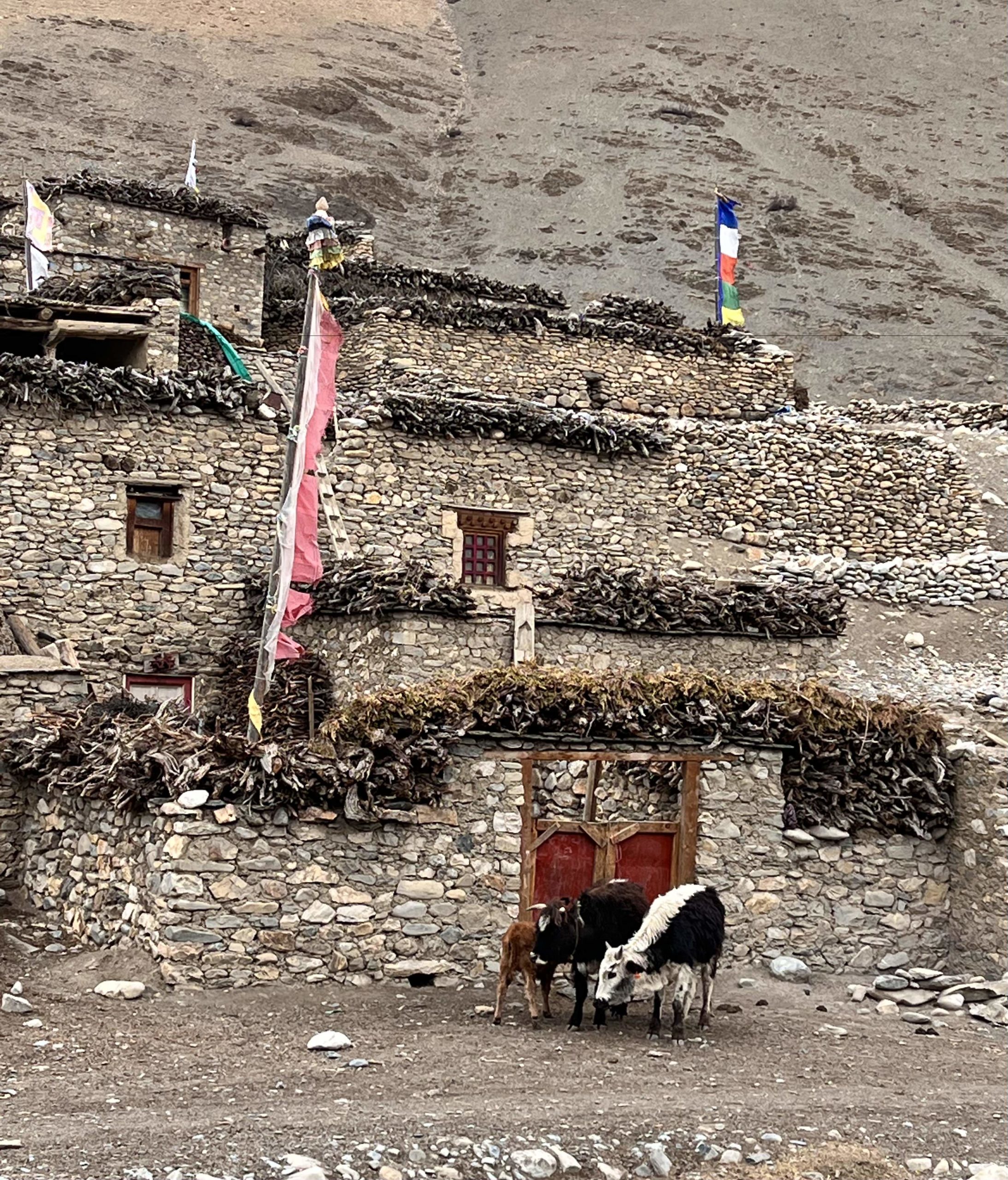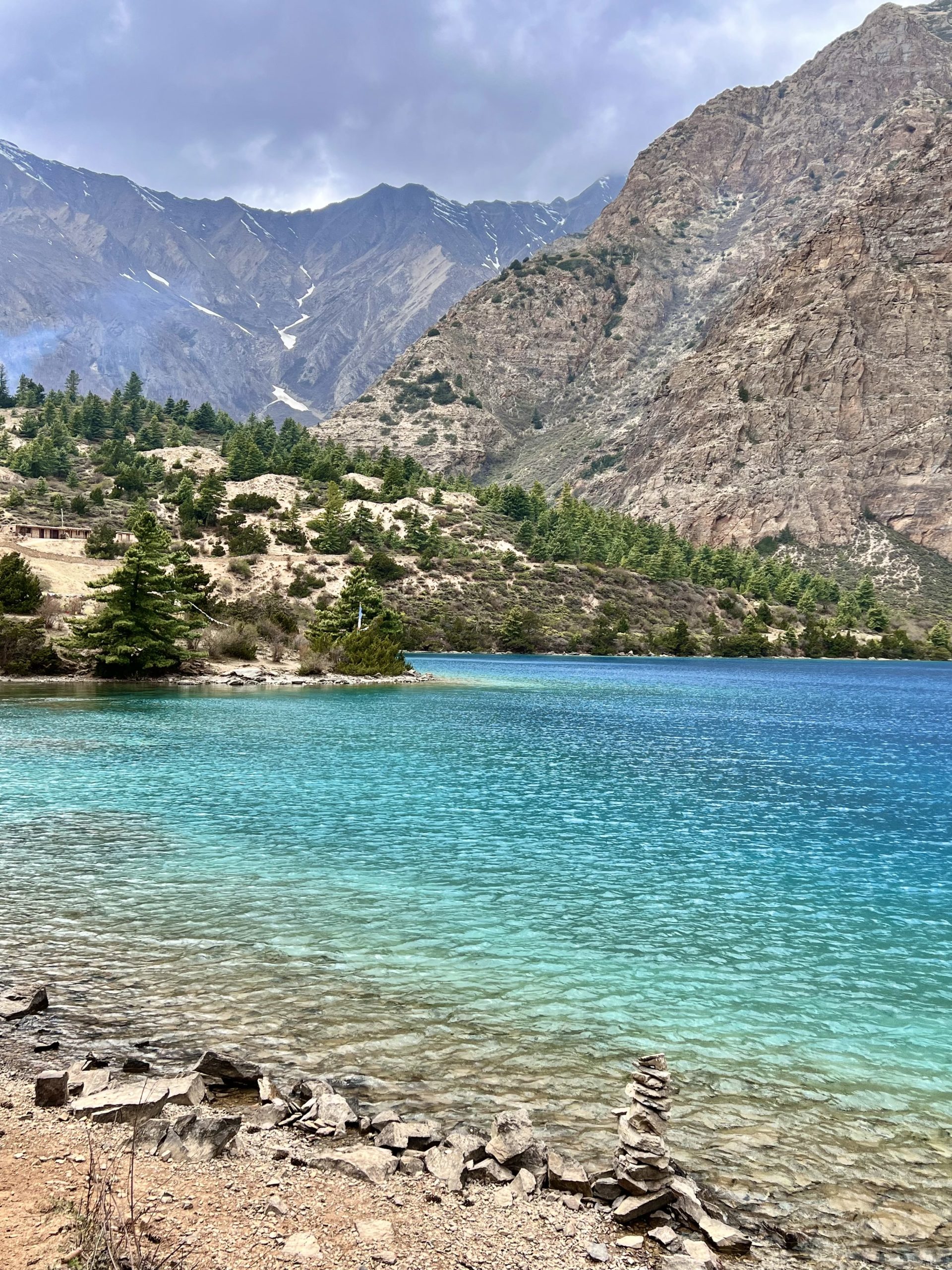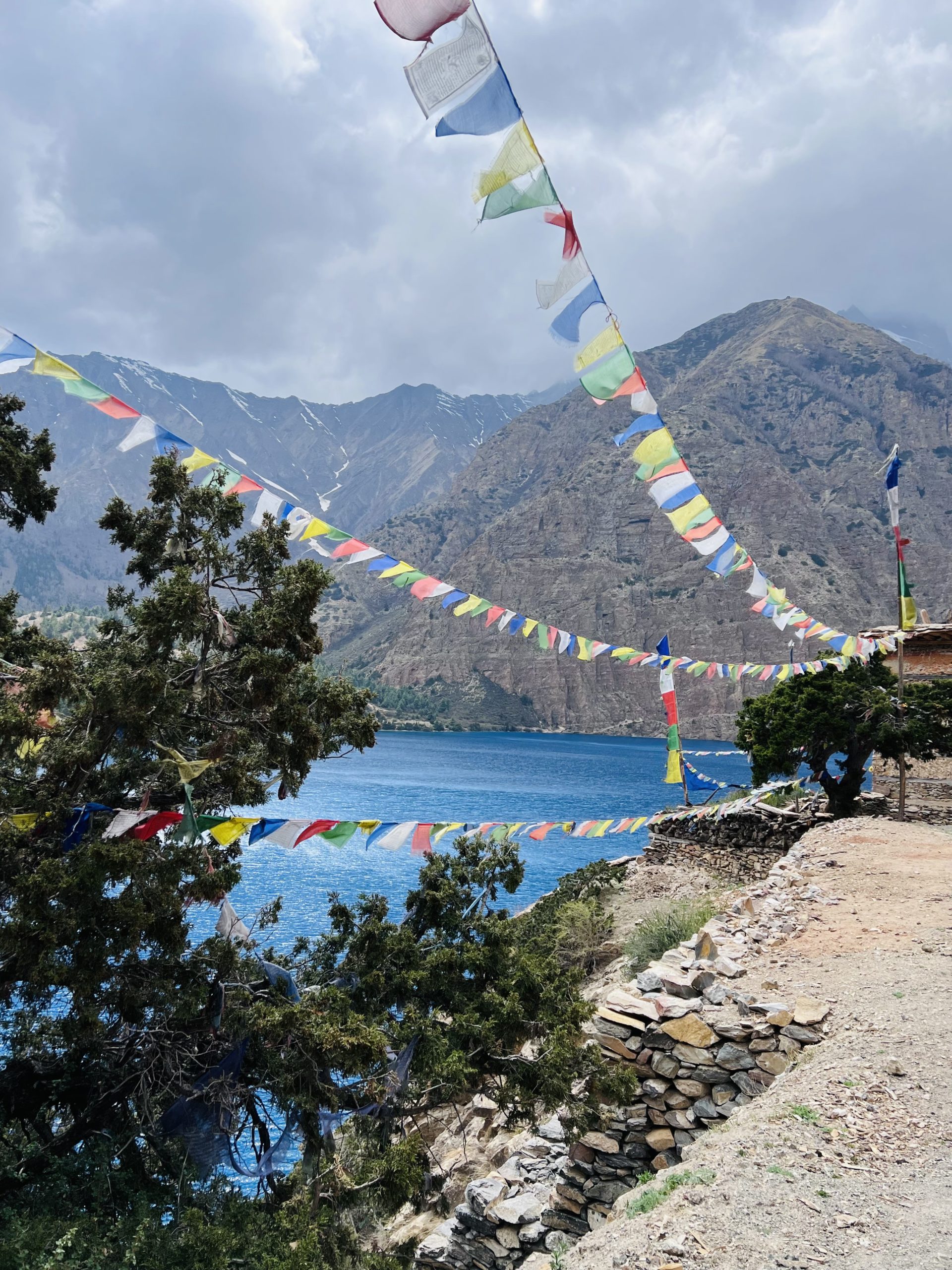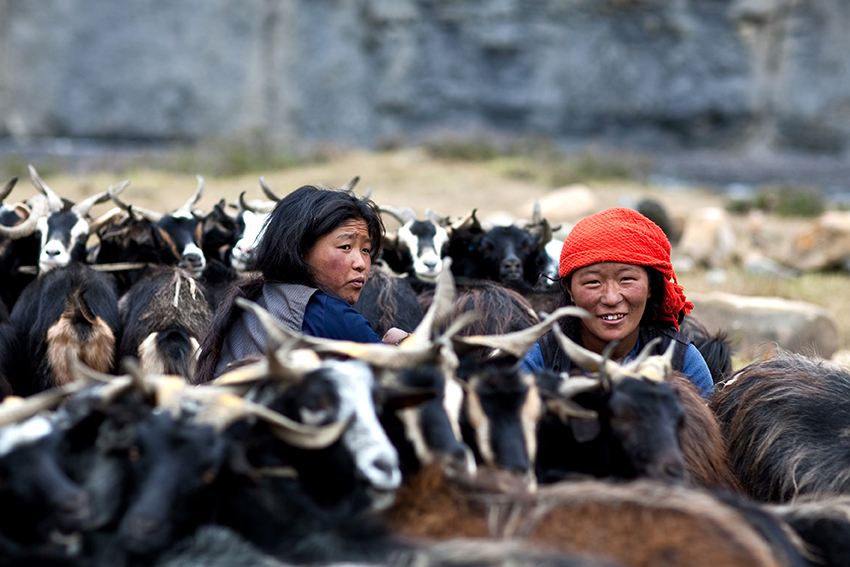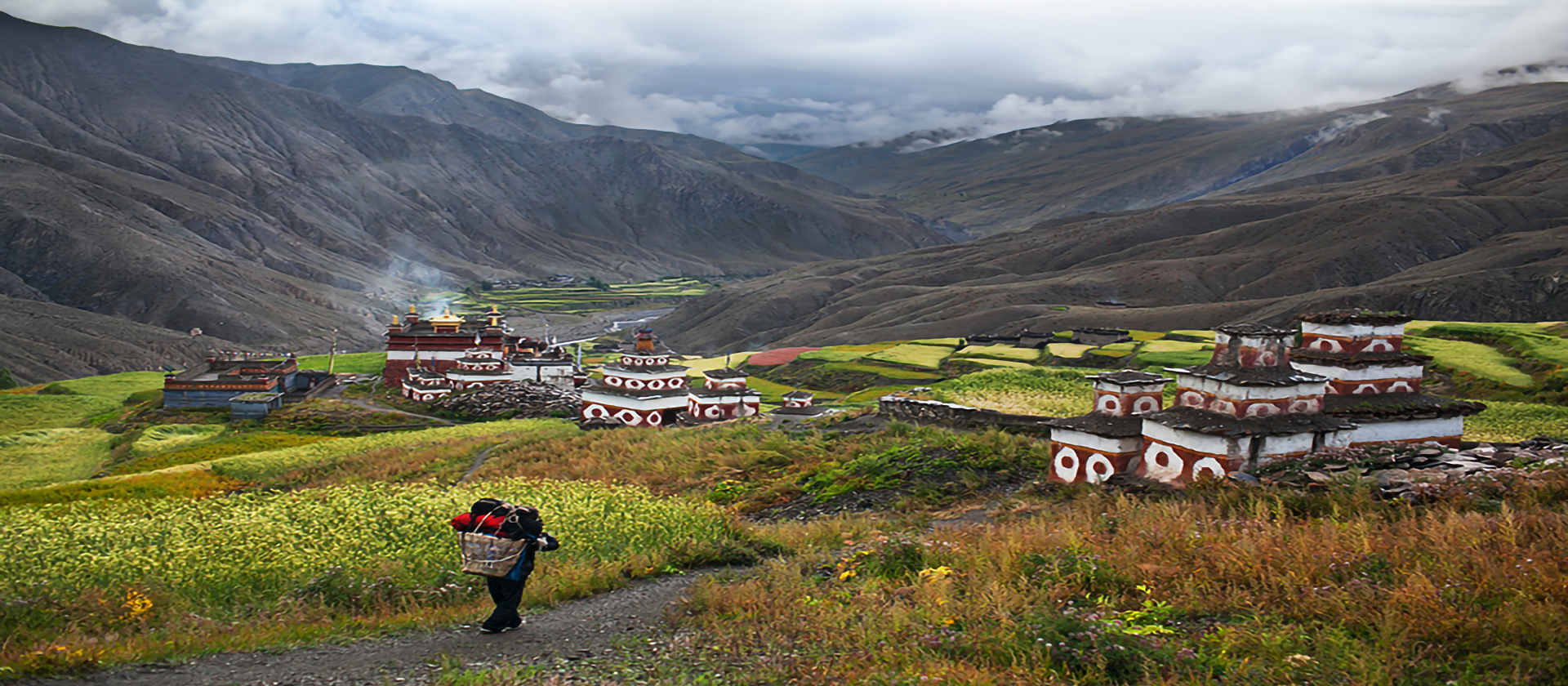
UPPER DOLPO ADVENTURE
EXPERIENCE THE MAGIC OF MYSTERY
- Home /
- Nepal /
- Trekking & Hiking /
- Dolpo Region /
- UPPER DOLPO ADVENTURE
Featuring: Do- Tarap, Phoksundo Lake, Shey Gompa & Yanger Gompa
Dolpo, the Himalayan trekkers’ forbidden Shangri-La, has long been one of the most remote secretive and restricted areas of northwestern Nepal. This region includes extensive areas of high arid Tibetan type terrain, undisturbed Buddhist cultures and an extensive natural history quite different from that of the Himalayas to the east. The few western travelers permitted into Dolpo were primarily scholars and researchers.
Within the last few years, the veil of secrecy has gradually been lifted. In the summer of 1989, the southern part of Dolpo was opened to foreigners. Since 1992, the government has opened the remaining parts of Inner Dolpo including Shey Gompa, the northern valleys, and the high passes from Tsharka over to the Kali Gandaki valley.
The best trip to inner Dolpo will be by early October when the summer monsoons would have subsided in western Nepal and the clear autumn skies offer spectacular views of the deep valleys and high snowcapped peaks. The weather should hold for about six weeks before the higher passes become snow-bound by the onset of cold winds and winter storms from the Tibetan plateau. This is our window of opportunity for exploration.
After landing at the airstrip at Juphal (6,900ft / 2,104m), start trek east to Dunai and then north toward Phoksundo Tal (11,570ft / 3528m), a high mountain lake that was formed many years ago when a massive rockslide swept down and blocked the Suli Gad River. The autumn red berries and the deep azure waters of the lake from an incredibly beautiful setting against a backdrop of high arid peaks and clear blue Tibetan skies.
Spend a few days acclimatizing at Phoksundo and visiting the nearby Monasteries at Pungmo and Ringmo before continuing on across the Khang La Pass (17,500ft / 5,335 m), the first of four high passes that is encountered on this trek. This will bring one to Shey Gompa, the spiritual center of Dolpo. Here one can find a Tibetan Buddhist Monastery where some of the most ancient rituals and traditions are still observed.
From Shey, we cross the Se La Pass (16,705ft / 5093m), and descend into valleys. Pass through Saldang, Yangsher, Shimen and Ting Kyu, some of the most remote villages. These areas have been visited by few foreigners and remain almost untouched by Western ways. Continue the trek across another high pass (16,500 ft / 5031m), to Tsharka, another very remote settlement in the upper Barbung Khola valley. From Tsharka, cross finally the Sangda La Pass (18100ft / 5519m), the last and highest of the all the passes. From here, one can have spectacular views of the northern slopes of the Dhaulagiri Range. Descend to Sangda and then to Jomsom in the Kali Gandaki valley. The treks end with a return flight to Kathmandu from Jomsom.
Since inner Dolpo is still a restricted zone, we must obtain a very special Restricted Area permit from Home Ministry – Department of Immigration. This fee is paid directly to the government of Nepal and will be used to manage the development of tourism in Dolpo. This trip is for experienced hikers or trekkers, but technical mountaineering skills are not required. The remoteness from medical and communication facilities is matched by few other locations on earth.
Route Map
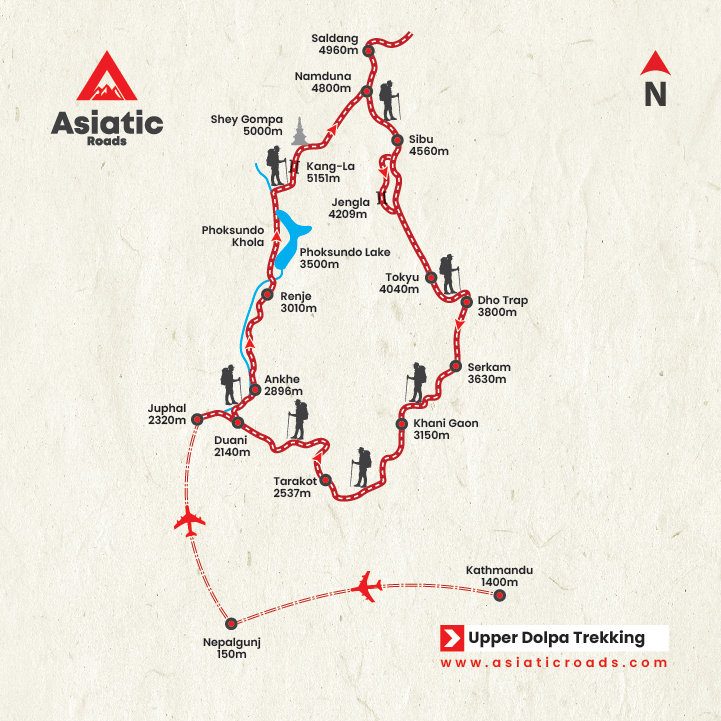
Itinerary In Detail
-
Day 01: Arrival in Kathmandu
Upon arrival at Tribhuvan International Airport (Kathmandu), meet, assist & transfer to the hotel.
Overnight at the hotel in Kathmandu. -
Day 2: Day in Kathmandu
Day in Kathmandu to submit the applications by the trek participants to obtain the special permits. Meantime we will organize a half the heritage tour of ancient Kathmandu City, including the visit of Temple of Pashupatinath, one of the holiest pilgrimage shrines of Hindus; Boudhanath Stupa, one of the biggest stupa and Hanuman Dhoka Durbar Square.
Eve: free for pre-trek preparation.
Overnight at the hotel in Kathmandu. -
Day 3: Fly to Nepalgunj
Transfer to the domestic airport of Kathmandu for the 45-minutes flight to Nepalgunj. Upon arrival at the Nepalgunj Airport, transfer to the hotel.
Overnight at the hotel in Nepalgunj. -
Day 04: Fly to Juphal & Trek to Dunai – 2 hours.
Early morning transfer to the Nepalgunj Airport for the 40-minutes flight to Juphal. Upon arrival start trek to Dunai. Follow the trail eastwards of Dunai along the south banks of the Thulo Bheri. Trek duration: 2 hours.
Dinner and Overnight at Dunai. -
Day 05: Trek to Chepka (2,670 m) – 5/6 hours
Cross the steel suspension bridge following the trail through the Thulo Bheri. Walk through Suli Gaad to Raktang (2,260 m). Cross the west bank & trek to Jyalhasa. Keep walking upstream to another bridge to the east bank to Ankhe Khola. Trail through ups & downs to Rahagaon & Parela to the high ridge above. After descending on a rocky path, arrive at Chepka (2,670 m).
Dinner and Overnight at Chepka. -
Day 06: Trek to Renje (3,010 m) – 6/7 hours
Climbing over a small ridge, cross to the west side to avoid a large ridge & returning to the east side along the riverside to the rocks & sticks forming dyke. The trails make several ups & downs through the forests to a bridge to the Renje. Trek duration: 6 hours.
Dinner and overnight at Camp. -
Day 07: Trek to Phoksundo Lake (3,730 m).
Climb over a ridge and descend to a wooden bridge & then continue its ups & downs along the valley floor to the Suli Gaad. A wooden bridge leads to the western bank of Phoksundo Khola, the trails follows the west bank of the river. Trek to Sumduwa, cross the bridge & climb through a forest of big cedars to Palam (3,710 m). The route switchbacks steeply on a sandy trail to the dusty switchbacks at 3,780 m. From the ridge you can see the spectacular views of Phoksundo Lake & 200m high waterfall. Steep decent trail in birch forests to the upper you will be in Ringmo village. Cross a bridge & follow a trail north to the ranger station at Phoksundo Lake. Trek duration: 7 hours.
Dinner and Overnight at Camp. -
Day 08: Rest day to explore around Phoksundo Lake
Phoksundo Lake
The lake is spectacular. It is 4.8 km long, 1.8 km wide and is said to be 650m deep. It is known for its aquamarine color-a greenish blue similar to a special Tibetan turquoise. There is no aquatic life in the lake, which helps to make the waters brilliantly clear. If you toss a rock in, you can watch it for a long time as it sinks to the bottom. According to legendPhoksumdo Lake was formed by a spiteful female demon. In Buddhist Himalaya David Snellgrove recounts how the demon was fleeing from the saint Padmasambhava and gave the village people a turquoise after they promised not to tell that she had passed by. Padmasambhava turned the turquoise into a lump of dung, which upset the local people so much that they revealed the demon’s whereabouts. She in return, caused the flood. It is said that you can see the remains of a village below the surface of the lake.
This is Bon-po country, where people practice a shamanistic religion that predates Tibetan Buddhism. Much of Bon-po symbolism is the opposite of Buddhist practice. You should walk to the right of the ancient mud chortens, which are inscribed with swastikas that have their arms pointing in the opposite direction to the Buddhist version. Instead of the Buddhist chant of “Öm Mani Padme Hum”, the Bon-pos chant “Om Ma Tri Mu Ye Sa Le Du”, which Snellgrove found untranslatable except that Sa Le Du in Tibetan means “In Clarity Unite”. A trail leads from the lakeside through juniper trees to the white Pal Sentan Thasoon gompa that overlooks the Lake. This is a Bon-po gompa said to have been built 60 generations ago. There are five other private gompas in various houses of the small monastic community near the lake. The insides of the temples contain dusty Buddhist paintings and statues, but the trappings also reflect the animistic elements of the Bon-po religion, so some of the chapels are reminiscent of an ancient witch’s cavern. A donation to the ragtag collection of dirty monks will gain you entrance to the gompas; if you’re traveling with sherpas they will be as fascinated as you by the strange iconography and practices of the Bon-po religion.
Dinner and Overnight at Camp. -
Day 09: Trek to Phoksundo Khola – 7/8 hours.
From Ringmo, at the southern and of Phoksundo Lake, the trail contours on a rocky ledge as it stirs the western lip of the lake. A precarious trail suspended on a gangway of wood supported on pegs driven into crevices in the rocks signals the remoteness of the area you are about to enter, Beyond a stream, the trail makes a steep climb onto a hillock overlooking the lake. It descends and continues above the lake on an up-and-dawn trail to pine forest, then makes a steep climb descent to the westernmost edge of the lake. Where the Phoksundo Khola enters the lake, there is a lush meadow that opens up into a long valley. Continue through the valley, crisscrossing the Phoksundo Khola and avoiding thorn bushes. The valley has steep sides with tundra and occasional boggy marsh underfoot. Trek duration: 7 hours.
Dinner and Overnight at Camp. -
Day 10: Trek to Snowfield Camp – 7/8 hours
Continue along the level path that now heads due north though a glacial valley. At the confluence of the Phoksundo Khola and another mountain stream there is an old wooden bridge. You should take the barely discernible path to the northeast up the valley. There is no trail, as such, so you need to climb over rocks and boulders and ford the stream that rushes down the steep incline of the valley. Along climb brings you to a sheep meadow where the trail veers up a steep ravine. A hard climb to the top brings you to yet another valley where you can see the Kang La, the pass leading to Shey Gompa. If you are in good shape and the porters agree, you might make it on to Shey in the same day, or you can camp before the pass in the place that Peter Matthiessen christened ‘Snowfields Camp’. Trek duration: 6 hours.
Dinner and Overnight at Snowfield Camp. -
Day 11: Trek to Shey- Gompa (4,500 m) -5/6 hours.
Climb up the steep hill littered with slate towards the pass. The climb is physically demanding especially when you slip and slide on the slate dump. From the top of the Kang La at 5,400m elevations, you can look down upon a large valley, which is bisected by a gushing over. Descend steeply to the valley floor and make a long, meandering trek along the banks of the river, crossing and re-crossing it several times. Notice the mud caves on the bank of the river and the hills overlooking the river. A red chorten heralds the gate to Shey Gompa. Continue along the path to a large meadow where hairy yaks and hundreds of sheep can be found grazing. There are a few nomads’ huts. Cross the river for the final time across a quaint wooden log bridge and climb up to the Shey Gompa compound at approximately 4500m.
The Gompa itself is not large, and there are no artefacts or paintings of note in its premises, except for an ancient Tibetan scroll that describes the myth of the Crystal Mountain and Shey Gompa. The monk who accompanied our trekking group managed to get hold of this manuscript and read it from over to cover. According to the book, in a crater in the mountain ranges that dominate Shey Gompa, there is a holy lake. When a pilgrim makes nine circumambulations of this lake the water turns into milk. A sip of this milk and the pilgrim can see Mt. Kailash in the distance.
A caretaker lives in a hut adjacent to Shey Gompa. To the east of the Gompa is the trail that leads to Saldang village, and eventually to Kagbeni via Charkabhot or south to Tarap. To the west of the Gompa, a narrow yak trail climbs up the valley floor to the remote village of Phijergaon. Trek duration: 5 hours.
Dinner and overnight at Camp. -
Day 12: Rest day at Shey- Gompa.
Rest day for acclimatization & explore around Shey Gompa.
Dinner and overnight at Camp. -
Day 13: Trek to Namgung (4,430 m) – 8 hours
Trek east from Shey Gompa & across the Shey La (5,010). Turn north & descend before climbing again to Namgung.
Dinner and overnight at Camp. -
Day 14: Trek to Karang (4,050 m) – 7/8 hours.
Traverse high above the Namgung Khola to Karang. It is also possible to descend to Saldang on the banks of the river, but this village holds little of interests.
Dinner and overnight at Camp. -
Day 15: Trek to Mugaon (4,100 m) – 7/8 horus.
Descend to Torak Sumdo (3,670 m), the confluence of the Namgung and Polang Kholas, & cross the northern bank. Climb to Yanger Gompa (3,750 m) and trek along the river to a side valley. There are a few campsites alongside the stream.
Dinner and overnight at Camp. -
Day 16: Trek to Shimen (4,010 m) – 7/8 hours.
Continue up the valley to Mugaon and climb towards the Mushi La at 5,030m. Descend towards Shimen Village.
Dinner and overnight at Camp. -
Day 17: Trek to Tinje (4,150 m) – 7/8 hours.
Descend to Shimen village & make a long trek upriver through Pha (4,090 m) to Tinje.
Dinner and overnight at Camp. -
Day 18: Trek to Rakpa (4,530 m) – 7/8 hours.
Trek to Rakpa start passing the runway of the mysterious Tinje Airport to a trail junction, where a high route leads to Tarap. Continue southwards to the campsite on the banks of river at Rakpa.
Dinner and overnight at Camp. -
Day 19: Trek to Chharka (4,120 m) – 7/8 hours.
Start a long climb to the Chharka La (4,920 m) from Rakpa. The trail then descends along the side of the valley, making a big drop into a side valley, then a long traverse down to the picturesque village of Chharka on the bank of Barbung Khola.
Dinner and overnight at Camp. -
Day 20: Trek to Norbulung (4,750 m).
Climb to a crest and descend again to the river. Follow the right fork southward, climbing in and out of side valley on a rough trail. The valley narrows, then emerges into a big meadow and climbs to the Norbulung.
Dinner and overnight at Camp. -
Day 21: Trek to Sangda Phedi (5,100 m) -7/8 hours.
Climb to a yak pasture at Molum Sumna and on to a crest. Make a long traverse across meadows to the foot of the Sangda La, then a long, steep final climb to pass the switchback down to the Sangla Phedi. Trek duration: 7-8 hours.
Dinner and overnight at Camp. -
Day 22: Trek to Sangda (3,700 m) -7/8 hours. (Exit from Restricted Area Zone)
Climb to lower Shangri-La, and then descend through loose shale towards the village of Sangde Ghunsa (4,190 m). Drop to the Chalung Khola, crossing and climbing steeply up the opposite bank. A long traverse leads to a cairn and then a set of steep switchbacks descends to a stream. Another climb to the compact settlement of Sangda ends a long day.
Dinner and overnight at Camp.
-
Day 23: Trek to Dhagarjun (3,290 m) – 7/8 hours.
Climb the hill behind Sangda and spend most of the day making a high traverse, crossing nine ridges to a final crest. Descend into the Kali Gandaki valley, traversing under high cliffs and descending to the large village of Dhagarjun.
Eve: Bid farewell party with Trekking Support team.
Dinner and overnight at Camp. -
Day 24: Trek to Jomsom (2,670 m) -3/4 hours.
Climb to a ridge and make a final descent on a dreadful trail of loose rocks to Jomsom. Rest of the day is free for rest and relaxation.
Dinner and overnight at teahouse lodge. -
Day 25: Fly to Pokhara.
Early morning transfer to the Jomsom Airport for the 25 minutes flight to Pokhara. Upon arrival at Pokhara Airport, transfer to the hotel in Pokhara.
In the afternoon, you may go for the sightseeing around Pokhara. The interesting places to visit are: Barahi Temple, Davis fall, Mountain Museum, Boating at Phewa Lake etc.
Dinner and overnight at Camp. -
Day 26: Fly back to Kathmandu.
Transfer to the Pokhara Airport for the 25 minutes flight back to Kathmandu. Upon arrival at Kathmandu, transfer to the hotel in Kathmandu.
Dinner and overnight at hotel. -
Day 27: Contingency day in Kathmandu.
Contingency day in Kathmandu in case of any delays due to weather or any other unforeseen reason.
Overnight at hotel. -
Day 28: Final departure from Kathmandu.
Free until final departure transfer to Kathmandu’s International Airport.
28 Days From
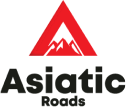
Any Question?
Feel free to call our travel experts.
+977 9851189018, +977 9801089018
info@asiaticroads.com
Date & Prices
| Start Date | End Date | ||
|---|---|---|---|
| August 18, 2024 | September 15, 2024 | Book Now |
Accomodations
Accomodation (Hotels envisaged or similar)
| Kathmandu | Hotel | 2 | BB |
|---|---|---|---|
| Nepalgung | Hotel | 1 | FB |
| Dunai | Tea House | 1 | FB |
| Chepte | Camping | 1 | FB |
| Ranje | Camping | 1 | FB |
| Phoksundo | Camping | 2 | FB |
| Phoksundo Khola | Camping | 1 | FB |
| Snowfield camp | Camping | 1 | FB |
| Sney-Gompa | Camping | 2 | FB |
| Namgung | Camping | 1 | FB |
| Karang | Camping | 1 | FB |
| Mugaon | Camping | 1 | FB |
| Shimen | Camping | 1 | FB |
| Tinie | Camping | 1 | FB |
| Rakpa | Camping | 1 | FB |
| Chharka | Camping | 1 | FB |
| Norbulung. | Camping | 1 | FB |
| Sangla Phedi | Camping | 1 | FB |
| Sangda | Camping | 1 | FB |
| Dhagarjun | Camping | 1 | FB |
| Jomsom | Hotel | 1 | FB |
| Pokhara | Hotel | 1 | BB |
| Kathmandu | Hotel | 2 | BB |
28 Days From

Any Question?
Feel free to call our travel experts.
+977 9851189018, +977 9801089018
info@asiaticroads.com
Additional Information
-
Clothing & Equipments
WHAT TO WEAR:
Light clothing is only for short treks up to seven days at altitudes up to 6000ft (1830m) during fall (autumn) from September to November and in spring between March to May. The other months at all altitudes will be cold and at most times the temperatures will be below zero.
Footwear:
You will need hiking boots with ankle support, sneakers for flat trails, and flip-flops or chappals for use around the camp/lodge.
Clothes:
Shirts, T-shirts (4), blouse, etc., for daywear and a woolen shirt/T-shirts for evenings.
MEN:
Shorts, cotton trousers, jeans, sweatpants (recon-mended), etc.
Undergarments & Socks:
Thermal underwear and inner trousers for the above 7,000 ft. treks. Thick trek socks.
Warm Clothes:
A light sweater, a windcheater or light lined/padded jacket, and a down jacket or parka for above 7000 ft. treks. Woolen thick cap and warm gloves.
Sun / Rain:
Rain gear or umbrella and a sun hat are essential. Global warming has led to freak weather conditions and it has become more and more difficult to predict weather conditions.
Note: Umbrellas are cheap and easily available in Kathmandu.
HOW TO PACK
In The Day Pack: In the Duffel Bag: Sunglasses Towels Moisturizing/Sunscreen lotion Spare batteries Prescribed medicines Toiletries Flashlight washing soap Camera and spare film Spare clothes all wrapped in plastic bags Binoculars-optional Reading Reference book/Notebook Pencil/Pen / Water bottles/ Trek permits Toilet paper Umbrella/rain gear / Sweater Note: Sleeping bags can be purchased in Kathmandu. It is even available on hire upon request. However, we request our clients to bring their own sleeping bags because of hygiene.
-
How To Train For Trekking
Many people worry that they are not fit enough for long treks, especially in the challenging Himalayan region. However with the right training realistic expectations, and healthy on-trail habits, Himalayan treks is possible for most of healthy hikers. Here are some tips for how to train for trekking in the Himalayas.
START EARLY
You will need to build muscle, endurance and your cardiovascular system. Do no put of training until a month before you leave. It is worth splurging a bit and hiring a trainer who can design a program specifically for what you are doing. If he or she can see you’re hiking Itinerary, even better. They will likely develop a plan that spans several months. Stick with it.
USE A COMBINATION OF EXERCISES
If you choose to develop you own plan (after careful research), use a variety of exercises. Including trail running ensures you will be confident on your feet on uneven terrain. You will also want to include box steps on boxes of varying heights while holding weights. Though you need to build strength to hike 4 to 9 or 10 hours in a day, it is also worthwhile to include sprint intervals, either running or on a bike. This improves your recovery time. Try short bursts of pushing a heavy sled to build your CV system to ensure you don’t feel like throwing up on the trail!! And do not forget your Arms! You should use your trekking poles, and these may give you more of a forearm workout tan you anticipate. Try some triceps extensions, as well as pull ups, rows and dips for your shoulders and back. You will, after all, be carrying a day pack.
STAYING HEALTHY ON TREK
Water is most important part of your hike. Drink at least 3/4 liters of water a day. Ensure yourself you are rehydrating all the time (Dehydration is one of the reason of Acute Mountain Sickness) . Stretch your calves, hips and gluteus any time you stop. This will minimize morning soreness and prevent injury. Bring bio freeze, icy hot, or Tiger Balm for rubbing on sore muscles at night (Tiger Balm is easily available in Kathmandu & Pokhara); these are practically helpful on and behind my knees after steep down hills. No matter what your diet is at your home, eat on a trail. All the teahouses serve pasta, rice, and pizza. Take an advantage of all those carbs. Avoid having alcoholic liquor especially while going up in the High Altitude.
WHEN YOU FINISH
The work you have done hiking will affect you even particularly painful, as your legs may be very restless for several days. Wear compression socks and try to get an aisle seat so you can walk around. After all this, you will definitely come away with a sense of exactly how strong your body is.
-
Notes For Trekkers / Travellers
Dear Guests,
Namaste & warm Greetings from Nepal!!We are very pleased that you have inquired for your trek with Asiatic Roads. The idea of this hand out is to furnish you with information for your pre-trek preparations.
Firstly, we recommend that you travel light. A good-sized duffel bag with a top length zipper that can lock is best, together with a day pack for carrying personal items on the trek. An extra smaller bag would be handy to carry back your souvenirs after the trip.
AFTER ARRIVAL IN KATHMANDU
1. TREK BRIEFING:
On your arrival in Kathmandu, we will arrange to meet for a pre-trek briefing. Full information on all aspects of your trek, questions and doubts will be discussed. On trek your Sherpa leader (sardar) will give you more details about the route, villages, people and other information regarding the trek.2. PACKING:
You may leave behind part of your luggage in your hotel or our locker room before the trek, in Kathmandu. All baggage is to be clearly marked and locked. Kindly refrain from carrying or wearing valuables on the trek. You may leave them behind at the safety deposit box at your hotel or with us.3. HOW TO PACK:
Your clothes and equipment should fall into the following 4 categories:1. What you are going to leave behind in Kathmandu.
2. What you are going to wear on the trail.
3. What you are going to carry in your day pack.
4. What you would like the porters to carry for you.Excess clothes and luggage can be stored in your hotel’s storeroom, and valuables in the safety deposit box. Please label your luggage and make sure to take a receipt from the front desk of your hotel for all the things you would like to leave behind while you are away.
ON TREK
1. YOUR STAFF ON THE TRIP:
Will consist of one English speaking Sirdar (Guide) and Assistance Guide or Escort who will be wholly responsible for the execution of the trip once it hits the trail. He will be assisted by Sherpa(s) as necessary.2. WHAT TO CARRY DURING THE TREK:
Your daypack, preferably waterproof should be light, small and comfortable. All small personal items like toilet paper, water bottle, medicines, extra shirt, light warm wears, rain gear, gloves etc. that may be needed for the days trek should be packed. Your duffel will be carried by porters who may not be with you at all times.3. MONEY ON TREK:
You may want to buy drinks at wayside shops and souvenirs from the natives. Small change should be carried. As customary, we can help discuss in detail in the pre-trek briefing.TREK KIT LIST
WHAT TO WEAR:
Light clothing are only for short treks up to seven days at altitudes up to 6000ft (1830m) during fall (autumn) from September to November and in spring between March to May. The other months at all altitudes will be cold and at most times the temperatures will be below zero.Footwear:
You will need hiking boots with ankle support, sneakers for flat trails and flip-flops or chappals for use around the camp/lodge.Clothes:
Shirts, T-shirts (4), blouse, etc., for daywear and a woolen shirt/T-shirts for evenings.MEN: Shorts, cotton trousers, jeans, sweat pant (recon-mended) etc.
Undergarments & Socks:
Thermal underwear and inner trouser for the above 7,000 ft. treks. Thick trek socks.Warm Clothes:
A light sweater, a windcheater or light lined/padded jacket and down jacket or parka for above 7000 ft. treks. Woolen thick cap and warm gloves.Sun / Rain:
Rain gear or umbrella and a sun hat is essential. Global warming has led to freak weather conditions and it has become more and more difficult to predict weather conditions.
Note: Umbrellas are cheap and easily available in Kathmandu.HOW TO PACK
In The Day Pack: In the Duffel Bag:
Sun glasses Towels
Moisturizing/Sun screen lotion Spare batteries
Prescribed medicines Toiletries
Flash light washing soap
Camera and spare film Spare clothes all wrapped in plastic bags
Binoculars-optional
Reading Reference book/Note book
Pencil/Pen / Water bottles/ Trek permits
Toilet paper
Umbrella/rain gear / SweaterNote: Sleeping bags can be purchased in Kathmandu. It is even available on hire upon request. However, we request our clients to bring their own sleeping bags because of hygiene.
ADDITIONAL ITEMS:
For most treks from mid-November till mid-February and for those above 10,000 ft. /3000 m., in Spring and Autumn, anti-dazzle glasses or goggles with side attachments are recommended and High altitude food supplements (favorite snacks) if necessary.IMPORTANT NOTE:
In the event of an accident or serious ailment on a trek, helicopter evacuation can be arranged. The helicopter fare with 10% service charge and the hospital/medical charge will have to be cleared before departing from Kathmandu. A risk, release and guarantee form has to be signed before leaving on a trek with us.INSURANCE:
There are no reliable medical insurance policies in Nepal for foreigners. We strongly recommend you to take comprehensive holiday insurance in your own country covering adventures involving some elements of risk, especially to cover Emergency Helicopter Evacuation.BOOKS:
Trekking in the Nepal Himalayas by Stan Armington published by the Lonely Planets books provides you comprehensive information on all matters regarding trekking in Nepal
The Trekkers Peaks of Nepal by Bill O’Connor published by Crow Wood press in U.K. provides you with information on all matters regarding climbing peaks in Nepal.
Trekking in Nepal by Toru Nakano published by Allied Publishers gives you some insight into some important trekking areas in Nepal. A map of Nepal is enclosed in the book. -
Visa Information
Tourist Visa
Immigration Offices, under Department of Immigration have been facilitating tourists flying to Nepal by providing Visa on Arrival. ‘On Arrival’ visa procedure is very quick and simple. You can expect some queues during peak Tourist season. If you wish to skip those queues, you can also consider getting Visa from Nepalese Diplomatic Missions stationed abroad prior to your arrival. Choice is yours.
If you have obtained visa from Nepalese Diplomatic Missions, then you must enter Nepal within six months from the visa issued date. Your total stay is counted starting from the day you enter into Nepal.
Visas obtained on Arrival at the Entry and Exit points are ‘Tourist Visas’. They bear multiple Re entry facility. Tourist Visa ‘On Arrival’ is the only entry visa to Nepal. If you are visiting Nepal for the purposes other than Tourism (sightseeing, tour, travel, mountaineering, trekking, visiting friends and families), you should still get ‘ Tourist Visa’ to get into the country. However, you must change the category of visa as per your purpose and length of stay in Nepal from Department of Immigration by producing required documents.
Nationals of following countries are requested to acquire Visa prior their arrival from their nearby Diplomatic missions (Embassies/consulates) of Nepal Government.
- Nigeria
- Ghana
- Zimbabwe
- Swaziland
- Cameroon
- Somalia
- Liberia
- Ethiopia
- Iraq
- Palestine
- Afghanistan
- Syria
- Refugees with travel document
Please follow these simple procedures for Tourist Visa on Arrival at the airport (TIA) if you have not acquired Visa prior to boarding the plane.
- 1st Step
- Fill in ‘ Arrival Card ‘
- Fill in Online ‘Tourist Visa ‘form ( you can fill it up prior to your arrival visiting our official website Department of Immigration / fill it up using Kiosk machines upon your arrival at the airport). If you fill it from the website, you will get submission Receipt with barcode, please print it out and bring it along for acquiring visa. It works for fifteen days and becomes invalid then after. If so, you will have to fill it up again.
- 2nd Step
- Make payment at the bank according to your visa requirement ( 15/30/90 Days)
- Get the receipt
While you can use different modes of payments (at visa fees collection counter), we advise you to carry some cash to be on the safe side.
On Arrival Visa Fee at Entry Points
15 Days – 30 USD
30 Days – 50 USD
90 Days – 125 USD
- 3rd Step
- Proceed to the Immigration Desk with your online form, payment receipts and your passport
- Hand in your documents to immigration officer for visa processing. He/she issues visa to you upon his/her satisfaction.
Visa Extension Fee
- Tourist visa extension is done for minimum 15 days with USD 45 and USD 3 per day for additional days.
- In the case of delay less than 150 days additional USD 5 per day as late fine.
Gratis Visa (Visa for Free)
Gratis Visa is issued free of cost in case of following categories of Visa applicants:
- Children below 10 years except US citizens
- Up to 30 days for SAARC Citizen (except Afghanistan) visiting Nepal for the first time in a given visa Year. Afghan citizen are eligible for Gratis Visa on Arrival only upon the recommendation of Department of Immigration. If you are an Afghan citizen, you can request concerned institution inviting you to Nepal for necessary paperwork with Department of Immigration to get you Gratis Visa ‘On Arrival’.
- Non Residential Nepalese(NRN) card holder ( issued by MoFA /Nepalese diplomatic missions abroad)
- Chinese Nationals for 150 days
Officials from
- Thailand – Exemption up to 90 Days
- Russian Federation – Exemption up to 90 Days
- People’s Republic of China – Exemption up to 30 Days
- Federal Republic of Brazil – Exemption up to 90 Days
- Myanmar – Exemption up to 90 Days
- Vietnam – Exemption up to 90 Days
- Cambodia – Exemption up to 30 Days
- Mongolia – Exemption up to 90 Days
- Jordan – Exemption up to 90 Days
- State of Israel – Exemption up to 90 Days
- Georgia – Exemption up to 90 Days
- State of Qatar – Exemption up to 90 Days
do not need Entry Visa based on reciprocal visa waiver Agreement
Visas of all kinds including ‘Gratis’ issued at the Airport are Tourist Visas. Contact Department of Immigration for extending your visa or changing the category of your visa. Tourist Visa extension can be done from Immigration Office, Pokhara too. Non tourist visa extension can be done only at Department of Immigration (if eligible) for a period of maximum one year (except business visa).
-
Notes On Acute Mountain Sickness
Key to acclimatization: Is adequate hydration, adequate nutrition & managing personal comfort through adequate layers lead to acclimatization.
Following extracts are taken from “The Wilderness First Responder” by Buck Tilton, director of Wilderness Medicine Institute of NOLS, USA
Dehydration
Without water there would be no life – at least no life, as you know it…
Water puddles inside every one of your cells, and flows through the microscopic spaces between cells. In water, oxygen and nutrients float to all parts of your body, and waste products are carried away. When your kidneys remove waste from your body those wastes have to be dissolved in water. Digestion and metabolism are water-based processes, and water is the primary lubricating element in your joints. You even need water to breathe, your lungs requiring moisture to expedite the transfer of oxygen into blood and carbon dioxide out of blood. Sweat, as mentioned, is mostly water. The water in your blood carries heat from warmer body parts to cooler areas of your anatomy when you are exposed to cold. In short, if aren’t well hydrated, you won’t be able to stay healthy, maximize your performance, or even maintain joy at being outdoors.
The water in your body, the fluid that keeps you alive and active, leaves you at an alarming rate. Estimates vary widely, but an average person at rest on a normal day loses between two and three liters of water. One to one-and-a-half liters rushes out as urine, and another one-tenth liter in defecation. Moisture is lost from act of breathing, more than half a liter per day, and that rate increases in dry winter air.
Then there’s sweat. The fluid lost in perspiration can climb to one to two liters per hour during periods of strenuous exercise. Compared to watching TV all day, one hour of exercise may demand approximately a 50 percent increase in the amount of water your body uses.
Your thirst mechanism that feeling of ”Gosh, I need a drink of water”, doesn’t kick in until you’re about one to one-and-a-half liters low. Down three to four liters can leave your endurance decreased to 50 percent and your oxygen uptake reduced close to 25 percent…
Acclimatization
The medical problems collectively referred to, as “altitude illnesses” is the result of hypoxia, insufficient oxygen in the blood for normal tissue function, a result of the decreased barometric pressure at higher altitudes. When you go up, the barometric pressure goes down, the concentration of oxygen in the air decreases, and the chance of altitude illness climbs.
Since there is a measurable increase in ventilation and decrease in aerobic exercise performance above 4,000 feet elevation, “high altitude” can be said to start at that point. Complications seldom occur, however, below 8,000 feet. In defining terms, consider 8,000 to 12,000 feet as high altitude, 12,000 to 18,000 as very high altitude, and 18,000 plus as extreme high altitude.
The human body will adjust to dramatic changes in barometric pressure, given enough time. Altitude illnesses – which range from mildly disturbing to completely fatal – are determined, primarily, by three factors:
How high the patient goes.
- How fast the patient attains a specific altitude, and
- Predisposing factors such as genetics and previous upper respiratory illnesses.
- Critical to acclimatization is adequate hydration and nutrition.
PREVENTION:
As mentioned earlier, most people will adjust to altitude given enough time. Staged ascent is the key to acclimatization and, therefore, the key to preventing altitude illnesses.
Adequate hydration is critical to the prevention of altitude illnesses. You should drink enough water to keep your urine output clear and copious.
A high calorie diet is essential for the energy needed to ascend and acclimatize.
Avoid respiratory depressants, such as sleeping pills and alcohol.
…But physical fitness prior to ascent is a bonus in the game of safety and enjoyment. Fitness does not, however, protect against acute mountain sickness.
(Friends: this is just to inform you about these important factors that we would be dealing in on the mountain. I know that there would be a lot of questions in your mind – how does one acclimatize, what food is to be taken, what are the early signs and symptoms that would alert me to start taking extra efforts to stay hydrated/acclimatized, etc. etc.)
28 Days From

Any Question?
Feel free to call our travel experts.
+977 9851189018, +977 9801089018
info@asiaticroads.com
Reviews
In my 2 week stay, John was very professional and took me around to experience all that Kathmandu and surrounding areas has to offer. Sites were seen and many locals were met through John’s network.

Steven Stone
TravellerIn my 2 week stay, John was very professional and took me around to experience all that Kathmandu and surrounding areas has to offer. Sites were seen and many locals were met through John’s network.

Steven Stone
Traveller28 Days From

